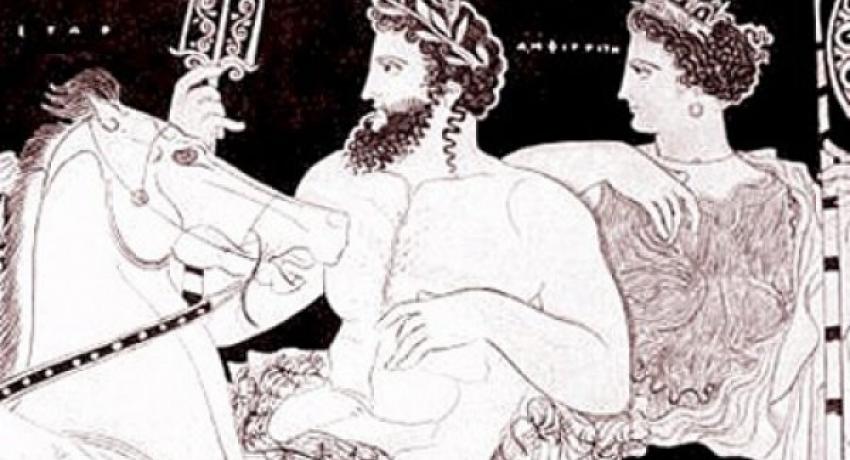Paxos Mythology & History
Podeidon & Amphitrite
MYTHOLOGY
According to mythology the islands of Paxos were created when the god of the sea, Poseidon, hit the island of Corfu with his trident breaking off its southern tip in order to form Paxos, where he could keep his lover Amphitrite. However,in the process he lost his trident which was found by the islanders who made it into their island emblem.
HISTORY
Homer was the first to refer Paxos, whose inhabitants were Greek–speakers from Epirus. The first colonists were probably the Phoenicians who had a colony on neighbouring Cephalonia.
432 b.c.: In the waters off the coast of Paxos (referred to as ``the islands of Syvota``), the largest naval battle up to that date amongst the Greeks took place, between the inhabitants of Corfu and the Corinthians; 70 Corfiot and 30 Corinthians triremes were sunk..
229 b.c.: The powerful fleets of the Illyrian pirates (inhabitants of the eastern shores of the Adriatic) and those of the inhabitants of Corfu, clashed off the coast of ´´so-called Paxos´´.The Illyrians won and occupied Corfu (and the islands of Paxos).This victory precipitated the first direct Roman intervention into Greek matters. One year later, the Romans gained victory over the Illyrians and forced them to concede lands and pay taxes.
31 b.c.: In the region of Paxos, the fleets of Caesar Octavius and Mark Antony in alliance with Cleopatra, were defeated and ended with the sea battle of Actium. It is thought that at the end of the battle the fugitives Mark Antony and Cleopatra anchored in Paxos due to unfavourable winds..
960: The historian Liutprand, bishop of Cremona went to Paxos to write the third volume of his Histories in a tranquil environment. During the second half of the 13th century Corfu was incorporated into the sovereignty of Anjou, annexing Paxos as well.
1386: The island was conquered by the Venetians and ruled by princes and barons as a feudal holding for many decades.
1423: Baron Adam II San Ippolito asked for Venetian permission to build a fortress to protect the island from pirates. Two were built:one on the island of Agios Nikolaos opposite Gaios and the second at Lakka.
1537: An important sea battle against the Turks by the allied fleets of Spain, Venice and the Papal States took place near Paxos under the leadership of the Genoese admiral Andrea Doria. The Turkish ships were sunk and the sea around Paxos was filled with bodies. Hayrentin Barbarossa wanted to take revenge for the catastrophe caused by Doria. After plundering and taking prisoners, Barbarossa decided to lay siege to Corfu. He soon found himself in a untenable position, disbanded the siege and withdrew his forces, but not before causing immense destruction. In retaliation, the Turkish fleet under the leadership of admiral Barbarossa, went to Paxos and ravaged the island from end to end. Not a stick was left standing. The catastrophe was completed the following year, when Paxos became the base of operations for Turgut. The island became deserted.
1571: Once again the Turkish fleet, this time under admiral Lutsali Pasha, pillaged the island, slaughtering the remaining inhabitants and laying waste to everything they encountered. Any inhabitants lucky enough to escape resettled on the neighbouring islands.
1797 :After 411 years of occupation, the Venetians surrendered the Ionian Islands to the Republican French who remained there until 1799, when the Russians and Turks occupied Corfu.
1800: Under the Constition that was formed, the Ionian Islands were declared a Republic under the dominion of the Sultan and with the protection of Russia.
1807: Under the Treaty of Tilsit the Ionian Islands were granted to Napoleon¶s Imperial French. The English blockade brought starvation to the island and as a result the inhabitants of Paxos revolted in May of 1810, gained power from the French and raised the English flag. The French invaded once again and punished the revolutionaries severely.
1814: The English army, under Major Theodore Kolokotronis, landed in the area of Plani near Lakka and conquered the fort of Agios Nikolaos in Gaios without resistance.
1817 : The English granted a constitution to the Ionian Islands, which become know as the Republic of the Ionian Islands under English protection and with the first English Governor, Metland.
1821: Although its status as a protectorate strictly forbade involvement, the inhabitants of Paxos took part in the Greek Revolution and offered their services to the struggle for freedom. At the top of the list of heroes is the name of Georgios Anemogiannis, captain of a fire ship who gave his life to the cause at the age of 23 at Nafpakto (Lepanto).
1864: The flame of unification with Greece, which had for long been slowly burning, spread to Paxos as well. The parliamentarians from Paxos, Ioannis Vellianitis and Dimitris Makris, voted for unification in the Ionian Parliament on the May 21, 1864.
1912-13 :The inhabitants of Paxos offered their lives once again during the Balkan Wars as well as during the Asia Minor campaign and catastrophe of 1922. They welcomed all refugees driven to their shores with open arms and incorporated them into the local community.
1923: The Italians land in Corfu and Paxos for one month as retaliation by Mussolini for the assassination of the Italian general.
1940-41: The blood tax continues during the Greek-Italian War and the German occupation, finally ending with the tragic civil war. During the difficult years of the occupation the inhabitants of Paxos made their living from the olive oil trade. Most dealers crossed over to the shores of Epirus in their rowing-boats by night to exchang their oil for wheat, maize and barley.

